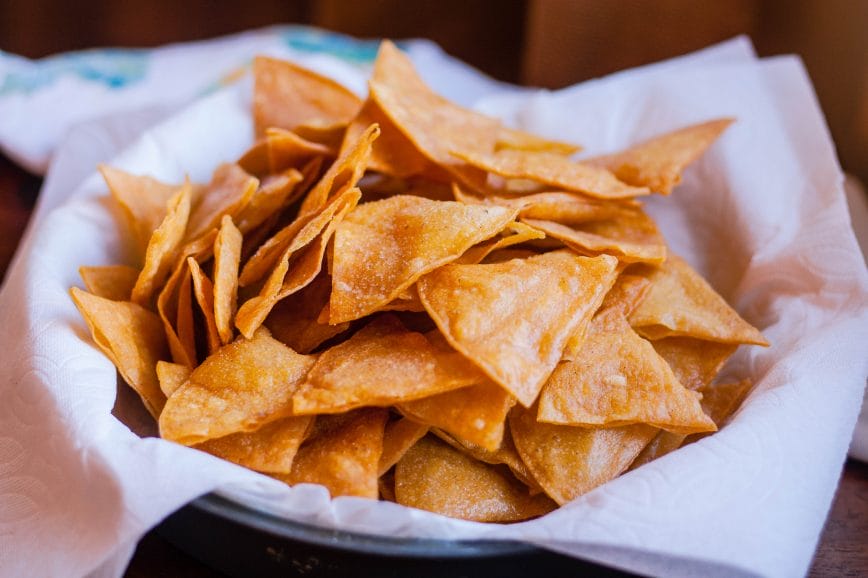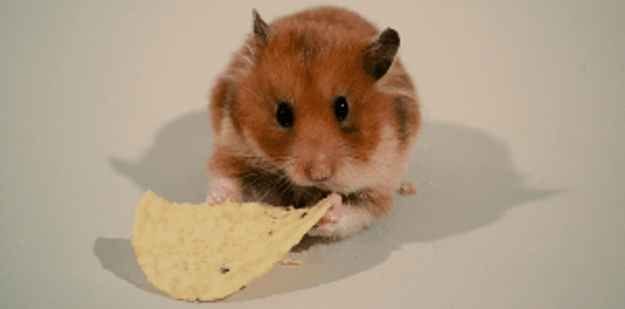Hamsters are small, curious creatures that enjoy a variety of foods, but when it comes to tortilla chips, caution is advised. While hamsters can technically eat tortilla chips in small quantities, they are not an ideal treat for them. The high salt content and spices in tortilla chips can be harmful to their sensitive digestive system.
Additionally, the crunchy texture may pose a choking hazard. It’s always best to stick to hamster-safe foods to ensure their health and well-being.

Potential risks of feeding tortilla chips to hamsters
While it may be tempting to share your snack with your furry friend, it is important to understand the potential risks of feeding tortilla chips to hamsters. Although they may seem harmless, certain ingredients and characteristics of tortilla chips can pose serious health hazards to these small pets.
1. High salt content:
Tortilla chips are typically loaded with salt, which can be extremely harmful to hamsters. High levels of salt can lead to dehydration, kidney problems, and even heart issues. Hamsters have very delicate systems and are not equipped to handle excessive amounts of salt like humans can.
2. Fat and oil content:
Tortilla chips are usually fried in oil, making them high in fat content. Hamsters have a very sensitive digestive system and a high-fat diet can lead to obesity and other health complications. It can also cause gastrointestinal distress, such as diarrhea or constipation.
3. Spicy seasonings:
Sometimes tortilla chips are flavored with spicy seasonings like chili powder. Spicy foods can cause irritation in a hamster’s digestive tract and may even lead to stomach ulcers. It is best to avoid feeding them anything spicy or heavily seasoned.
4. Choking hazard:
Hamsters are small animals with tiny throats. Tortilla chips, especially the larger ones, can pose a choking hazard if they are not properly chewed or broken down. The hard and crunchy texture of the chips can easily get lodged in their throats, leading to choking or blockage.
5. Allergic reactions:
Some hamsters may have allergies or sensitivities to certain ingredients present in tortilla chips, such as corn or gluten. Feeding them these chips can trigger allergic reactions, causing symptoms like itchiness, sneezing, or respiratory distress.
6. Nutritional imbalance:
Tortilla chips lack the essential nutrients that hamsters need to maintain a healthy diet. Feeding them these types of snacks can lead to nutritional imbalances and deficiencies, which can have a negative impact on their overall health and well-being.

Healthy Alternatives to Tortilla Chips for Hamsters
There are plenty of healthy alternatives that you can offer to your hamster as a snack. In this section, we will explore some nutritious and safe options to replace tortilla chips for your furry friend.
1. Whole Grain Crackers
Whole grain crackers are a great alternative to tortilla chips for hamsters. These crackers are made from whole grains, which provide fiber and essential nutrients. Make sure to choose plain, unsalted crackers to avoid any added ingredients that may not be suitable for your hamster. You can break them into smaller pieces to make it easier for your hamster to eat.
2. Veggie Sticks
Hamsters love crunchy vegetables, and veggie sticks are a perfect option to satisfy their snacking cravings. Carrots, cucumbers, and bell peppers can be cut into thin, long sticks and offered to your hamster. These vegetables are packed with vitamins and minerals that contribute to your hamster’s overall health. Remember to wash the veggies thoroughly and remove any seeds or pits before serving.
3. Rice Cakes
Rice cakes are a popular snack for humans, but they can also be a safe treat for hamsters. Opt for plain rice cakes without added flavors or seasonings. These low-calorie snacks provide a crunchy texture that hamsters enjoy. Just make sure to break the rice cake into smaller pieces to prevent choking hazards for your furry friend.
4. Dried Fruits
Dried fruits can be a tasty and healthy alternative to tortilla chips for hamsters. Offer small pieces of dried apples, bananas, or cranberries as occasional treats. However, keep in mind that dried fruits are high in natural sugars, so moderation is key. Too much sugar can lead to obesity and other health issues for hamsters.
5. Homemade Veggie Chips
If you’re feeling creative, you can make your own hamster-friendly veggie chips at home. Slice vegetables like sweet potatoes, zucchini, or kale into thin pieces and bake them in the oven until crispy. Homemade veggie chips are a nutritious and fun snack that your hamster will enjoy. Just remember to avoid using any seasoning or oil while preparing them.
6. Plain Popcorn
Plain, air-popped popcorn can be a safe and low-calorie treat for your hamster. However, it is essential to avoid using flavored or salted popcorn, as these additions can be harmful to your furry friend. Remove any unpopped kernels before offering popcorn to prevent choking hazards. Remember to serve popcorn in moderation to maintain a balanced diet for your hamster.

How to Introduce New Food to Your Hamster’s Diet
While hamsters have specific dietary needs, it can be beneficial to introduce new foods to their diet to add variety and provide additional nutrients. However, it is essential to introduce new foods gradually to prevent digestive issues and ensure your hamster’s well-being. In this section, we will discuss the steps to introduce new food to your hamster’s diet.
1. Research and Choose Suitable Foods
Before introducing any new food to your hamster, it is crucial to research and ensure it is safe and suitable for your furry friend. Some foods can be toxic to hamsters, so be careful and select only those that are recommended for them. Fresh fruits, vegetables, and specific grains are generally safe choices.
2. Introduce One Food at a Time
When adding new foods to your hamster’s diet, it is best to introduce them one at a time. This approach allows you to observe if your hamster tolerates the new food well or develops any negative reactions. Start with small quantities to prevent overwhelming their digestive system.
3. Gradually Mix the New Food
Begin by mixing a small amount of the new food with your hamster’s regular diet. This gradual introduction will help your hamster become accustomed to the taste and texture of the new food. Over time, you can increase the amount of the new food while decreasing the proportion of their regular diet.
4. Monitor Your Hamster’s Reaction
Keep a close eye on your hamster’s behavior and health during the introduction process. If you notice any signs of distress, such as diarrhea, vomiting, or a sudden change in appetite, it may indicate that the new food is not suitable for your hamster. In such cases, discontinue feeding the new food and consult a veterinarian if necessary.
5. Offer a Variety of Foods
Once your hamster has successfully adapted to a new food, you can continue to introduce other safe options to diversify their diet. Offering a variety of foods helps ensure they receive a wide range of nutrients and prevents boredom. Remember to rotate the types of food to provide a balanced and stimulating diet.
6. Be Mindful of Portion Sizes
While introducing new foods, it is important to monitor the portion sizes given to your hamster. Hamsters have small stomachs and can quickly become overweight if overfed. Adjust the amount of new food according to your hamster’s size, age, and activity level to maintain a healthy weight.
7. Consult a Veterinarian
If you have any concerns about introducing new foods to your hamster’s diet or if you notice any unusual health symptoms, it is always best to consult a veterinarian. They can provide professional advice tailored to your hamster’s specific needs and ensure their diet remains balanced and suitable for their overall well-being.
Tips for providing a balanced and nutritious diet for your hamster
Providing a balanced and nutritious diet is crucial for your hamster’s overall health and can help prevent common health issues. Here are some tips to help you provide the best diet for your furry friend:
1. Choose high-quality hamster food
When selecting food for your hamster, opt for a high-quality commercial hamster mix. These mixes are specially formulated to provide a well-balanced diet for hamsters and usually contain a combination of grains, seeds, vegetables, and fruits. It’s important to check the ingredient list and ensure that the mix doesn’t contain any harmful additives or excessive amounts of sugar.
2. Provide fresh vegetables and fruits
In addition to the commercial hamster mix, it’s essential to include fresh vegetables and fruits in your hamster’s diet. These provide essential vitamins and minerals that may be lacking in the commercial mix. Some safe options include carrots, spinach, broccoli, apples, and berries. Introduce these foods gradually and in small quantities to prevent digestive issues.
3. Offer a variety of proteins
Hamsters are omnivorous animals, and protein is an essential component of their diet. You can provide protein by offering small amounts of cooked lean meats like chicken or turkey, or boiled eggs. Alternatively, you can opt for commercially available hamster treats that contain protein-rich ingredients like mealworms.
4. Avoid harmful foods
While it’s important to offer a variety of foods, there are certain foods that can be harmful to hamsters and should be avoided. These include chocolate, caffeine, alcohol, onions, garlic, grapes, and citrus fruits. These foods can be toxic to hamsters and may cause severe health issues.
5. Provide fresh water
Water is essential for your hamster’s hydration and overall health. Ensure that your hamster has access to fresh, clean water at all times. You can provide a water bottle with a sipper tube attached to the cage, which prevents contamination and spillage.
6. Offer hay and chew toys
Hay is an essential part of a hamster’s diet as it provides necessary fiber. Along with hay, you can also offer chew toys made from safe wood materials, such as applewood or birch. These toys help to keep your hamster’s teeth healthy and prevent overgrowth.
7. Avoid overfeeding
It’s important to provide your hamster with appropriate portion sizes to prevent obesity and related health issues. Hamsters have small stomachs and can easily overeat if given the opportunity. Follow the recommended feeding guidelines based on your hamster’s age and size, and monitor their weight regularly to ensure a healthy balance.
8. Observe your hamster’s eating habits
Every hamster is unique, and their dietary needs may vary slightly. Observe your hamster’s eating habits and adjust their diet accordingly. If you notice any significant changes in appetite or weight, it’s advisable to consult a veterinarian for guidance.
Can hamsters eat tortilla chips?
No, it is not recommended to feed tortilla chips to hamsters. These chips are high in salt and unhealthy for hamsters. It is important to provide them with a balanced diet of specially formulated hamster food and fresh fruits and vegetables.
How often should I clean my hamster’s cage?
You should clean your hamster’s cage at least once a week. Remove any soiled bedding, clean the cage with a mild pet-safe cleaner, and replace it with fresh bedding. Regular cleaning helps maintain a clean and healthy environment for your hamster.
What is the lifespan of a hamster?
The average lifespan of a hamster is around 2 to 3 years. However, some hamster breeds, such as the Roborovski hamster, can live up to 4 years or even longer with proper care. Providing a suitable diet, exercise, and a stress-free environment can contribute to their longevity.
Conclusion:
While hamsters can eat a variety of foods, it is best to avoid feeding them tortilla chips. These chips are typically high in salt, fat, and processed ingredients, which can be harmful to your furry friend’s digestive system.
Instead, opt for hamster-safe snacks such as fresh fruits, vegetables, and small amounts of seeds or nuts. Remember to introduce new foods gradually and monitor your hamster’s reaction to ensure their health and well-being.
By providing a balanced and appropriate diet, you can help your hamster live a happy and healthy life.

